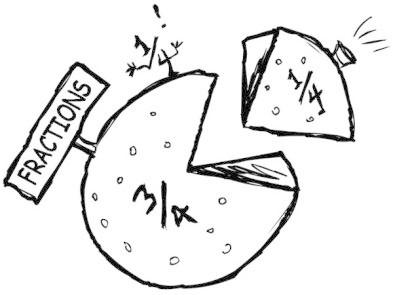The most common question a math teacher will receive from their students is “When will I ever use this in my life?” Many students have the impression that mathematics has no applications to the world, and that after they finish school they will never use the information they have learnt. In some cases, this is true, some of the math concepts students learn are complex and their applications require some further information to learn. However, much of mathematics can be applied to our daily life.
An example of this application is fractions. As an Elementary or Middle School student is learning this seemingly tricky math concept, some ask “When will I ever use this in my life?” At Mathnasium, we focus heavily on studying fractions because we know of their important applications and because fractions are one of the topics that many students (and some adults) struggle with. At our center, our students are taught to have a strong understanding of fractions. They study what fractions are and how to manipulate them with various mathematical operations like addition and multiplication. Students are further encouraged to model fractions using diagrams, allowing them to have a concrete understanding of the concept.
A simple trip to the grocery store offers a great example of the use of fractions. For instance, you may be in the dairy section trying to decide if you should by a 2L carton of milk for $5 or three 1L bags of milk for $6. What’s the better buy? Understanding fractions and how prices and quantities relate in a unit price can be useful in making your decision. You can represent the price per quantity relation of the carton by the fraction $5/2L which our students know give the unit price of $2.50/1L . Next, you can represent the price per quantity relation of the three bags by the fraction $6/3ð¿ which our students also know gives the unit price of $2/1ð¿ . You can compare these two unit prices with an inequality, $2.50/1ð¿ > $2/1ð¿ , resulting in the three 1L bags of milk being the better buy. Moreover, notice that a strong understanding of fractions and the ability to simplify and manipulate them allowed for you to model the grocery store scenario using mathematics. There are numerous applications of fractions beyond the grocery store in daily life that students will encounter, hopefully encouraging them to continue studying them.
In High School, students are taught linear relations (lines) and how we can model them using their slope and y-intercept by a function, 𑦠= ð‘šð‘¥ + ð‘. High School students are taught that the variable m represents the slope, and the variable b represents the y-intercept. Further study of a line results in students understanding that when m is positive, m>0, the line has a positive rate of change which means when the line is graphed it will increase from left to right of the graph. And, the opposite behaviour occurs when m is negative, ð‘š < 0, resulting in the line having a graph that decreases from left to right. Similarly, a High School student is taught to identify that the y-intercept, b, represents the point (0, ð‘) when the graph intersects the vertical axis. Many High School students ask their math teacher “When will I ever use this in my life?” A line has various applications in many disciplines such as economics, physics and chemistry. In economics, an economist will model a microeconomy using demand and supply curves. In simple microeconomics, these curves can be modelled by lines.
For example, in the market of buying and selling oranges, the demand curve has a slope ð‘šð· that is determined by a consumer's willingness to pay per orange. In the orange market, a consumer could value the first orange at $5, the second at $4, the third at $3, and so on, giving ð‘šð· = −1. The supply curve has a slope ð‘šð‘† that is determined by a farmer’s cost to grow each orange. The farmer may spend $1 to grow the first orange, $2 to grow the second, $3 to grow the third and so on, giving ð‘šð‘† = 1. This results in two linear relations with equations ð‘¦ð· = −ð‘¥ + 6 and ð‘¦ð‘† = ð‘¥ with the graph represented in Figure 1. Economists can then determine important information about the market, like the number of oranges that will be sold in the market and for what price. This is determined by the Point of Intersection between the demand curve, ð‘¦ð· , and supply curve, ð‘¦ð‘† .

In this article, we discussed two important applications of math that our students are learning using fractions and lines. There are of course many more applications in daily life and other academic disciplines that students will discover as they continue their studies of mathematics. I encourage each student to explore different applications that interest them!
~ Joshua De Jesus



 (416) 858-6366
(416) 858-6366








